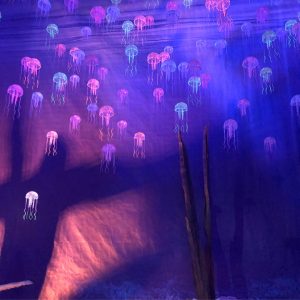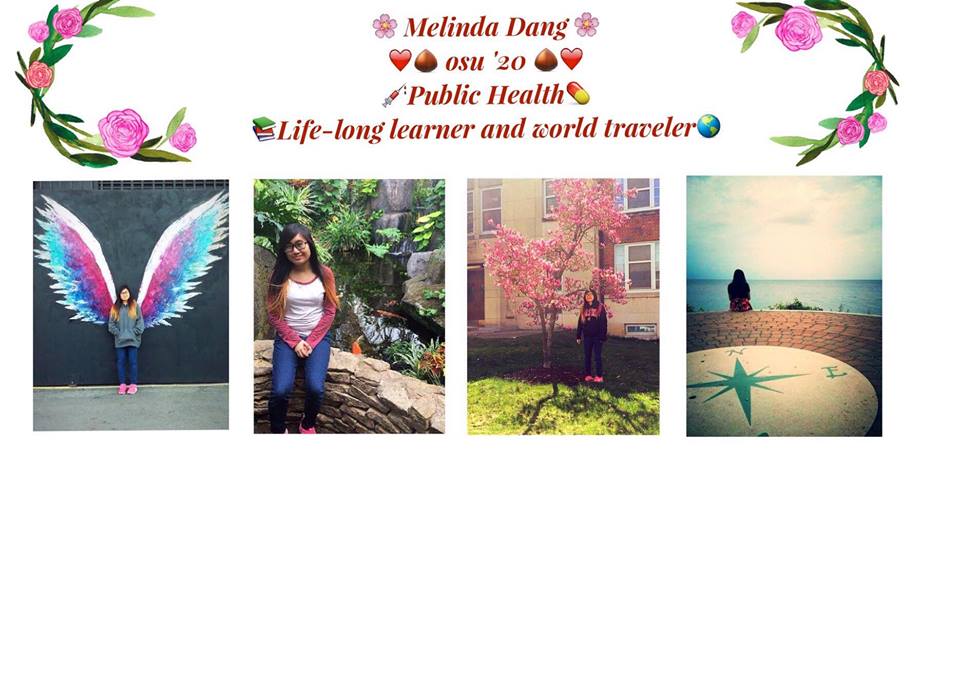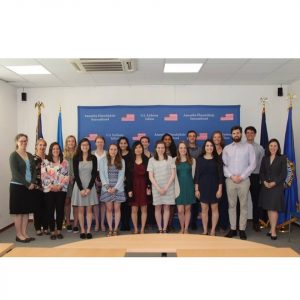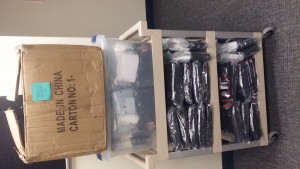“I am not the same having seen the moon shine on the other side of the world.” – Mary Anne Radmacher
Day 7 marked the halfway point of our study abroad program. In the morning, we took a bus to the Estonian Open Air Museum, designed to resemble a real-life rural village in the 18th century! This was one of my favorite parts of the program. This museum included 14 different farms to show aspects of village life. I saw cottages, a teepee, a giant windmill, a church, and more. One path lead to the seashore where my peers collected seaglass and waded their feet in the water. I really enjoyed this opportunity to be immersed in nature.
The group had a guided walking tour of Old Town; Joosep was a wonderful human encyclopedia as he showed us to spots we had not been to before. He taught us what the colors of the flag of Estonia meant: blue for the sky, black for the dark forests and the dark times Estonians have been through, and white for purity and hope for a brighter future.
2018 marks a special year of celebration for Estonians because this is the 100th anniversary of their independence as their own republic, free from endless rule by different countries.
I boarded a tram by myself to a nearby cat cafe. I have never been to any cat cafe before, and I wanted to see if cat breeds differed in Estonia. When I went to Nurri Cat Cafe, only five other people were present, with about 10 cats in the room. I did not see any unfamiliar breeds. My time at the cat cafe was very therapeutic for me. Although I did not get to pet the cats much, I enjoyed eating my pesto pasta and watching the cats interact with one another. I even witnessed the cats at dinner time (6 pm) and they each pounced their tiny paws over to their own bowls to feast.

Two cats were perched on top of the table where I was sitting. It takes a while for cats to get accustome to you and be comfortable with you approaching them to pet them.
Day 8 meant traveling to another city. We hopped on board a train from Tallinn to Tartu! Tartu has 99,000 people as of this year. This sleek train got us there in less than two hours; I napped the majority of the time. After setting down our belongings, we had a quick walking tour and lunch.

The Town Hall is a landmark of Tartu. Bells ring from the hall each day. The fountain of kissing students is in the lefthand corner of the photo; the fountain was erected in 1998.
We spent an hour at the KGB Cells Museum, which showcases the basement of a building that was used to house prisoners! Men and women alike were put together in a cell. Cell walls were so thick that no noise could be heard between rooms. Rooms lacked lighting and ventilation, and often had as much as 30 to 40 people within such a confined space and with just four beds!
For the rest of the day, I browsed around souvenir shops in Tartu. We were conveniently located right across from a University of Tartu building, and right by the town square. Tartu sidewalks are very wide and can fit three to four people in a row. After popping into a small bookstore, we went to the Botanical Gardens, which was founded in 1803. It is such a beautiful place and I would have liked to see the greenhouses but we were running out of time. Nevertheless, the grounds were great and the garden included a pond. We saw people taking photos for graduation and weddings here. For dinner, the class ate at Meat Market, which does not solely serve meat.

Gardens are a valuable part of any city. People need green space for not just oxygen but for stress relief.
Day 9 was a free day for everyone. Two friends and a program coordinator/graduate student accompanied me to the Upside Down House that was about 30-45 minutes away on foot. We crossed the river and went into the outskirts of the city of Tartu. The house was built upside down AND on a slant, so it was disorienting and dizzying. The house included a sauna and that was neat!

This house stood out from its surroundings in remote Tartu. There was an abandoned aircraft hangar in proximity, and also a designated walking path among some trees. Buses do run along the street but not frequently.

This photo can confuse people at first glance! There are actually some Upside Down Houses around the world, such as Germany and America. (I had no idea they existed in my own country!)
Nearby was the Estonian National Museum, which is a tremendous facility where we spent a few hours looking at artifacts related to Estonian life. We paid 10 euros as a student discount and could access the entire building. We received cards encrypted with a technology that allowed us to swipe the card over a screen connected to an exhibit/piece. The screen would then automatically translate to English. This is so innovative and I hope that museums elsewhere in the world could incorporate this! I enjoyed viewing prehistoric and Metal Age tools. Estonia has been inhabited by people for the last 11,000 years! My favorite exhibit hall was the one featuring Uralic people, a people I had no knowledge about beforehand! They lived between Scandinavia and the Ural Mountains, so were primarily in the forests. They carved symbols into trees and their tales often involve bears and other woodland creatures. The exhibit showcased a people and facets of their lifestyle, but this was just one small sliver of Ugric studies. Also in the museum was an exhibit about 19th century clothing. Women’s clothing was preserved more because not only were they more beautiful and colorful than men’s clothing, but they also reflected diversity among different regions of Estonia. I learned about the usage of headpieces and necklaces. I am glad to have visited this museum! The facility was marvelous.
After our fun free day in Tartu, I worked on a homework assignment that addresses how walkable the city of Tartu is. Now that I have been to the more touristy areas of Tartu and the more remote parts, I was able to come up with a convincing argument for how well-designed the city is so that people can enjoy it whether they walk or use a wheelchair. Sidewalks have ample space and curbs/ramps have good inclines. When you get to the less-inhabited parts of town, some sidewalks are harder to tread on, but it still is pedestrian-friendly. After returning to the hotel, I got dinner and dessert with other friends and then about half of the class played games in one of our rooms.
(Please see my assignment on the walkability audit of Tartu here:
https://docs.google.com/presentation/d/1EG8vBf1EuKn0Uz01klxOo9fXyKOzhBr_r0CJsku_0Hg/edit?usp=sharing)
I was also able to complete another homework assignment comparing cigarette sales in America, Finland, and Estonia. Throughout the program, we were expected to observe how cigarettes were sold (where and for how much money) and what the packaging looked like, including what information or graphics were put on the warning labels.
(Please see my work here:
https://docs.google.com/presentation/d/1kR8W4sjJjBN53qEh1lHJvOIS9BMUfnb9Uz_z770khhs/edit?usp=sharing)
For Day 10, the class visited the Ahhaa Science Centre, which reminds me of COSI in Columbus! I love science centers and this one has four floors! The ground floor had a LEGO town of Tartu and exhibits related to water. It included tech spaces, a play area with giant building blocks, music/acoustic space, and tanks with real fish in them. In a dark room were lifelike animatronic aquatic creatures such as dinosaurs with fins and a whale shark. There are some steps leading up to a balcony that had ant farms and an incubator for chicks! This was the highlight of the science center for me. I love baby chickens. The chicks were either a day old or two days old, and some eggs were close to hatching!

FUN FACTS: Jellyfish have existed even before dinosaurs roamed the planet. A group of jellyfish is called a bloom.

FUN FACTS: Whale sharks are the largest fish. They are giant but gentle and eat plankton and small fish. Their skeletons are made of cartilage, not bone. Female whale sharks are actually larger in size than male sharks.
On the second floor of the science museum were glass jars containing human and animal body parts and embryos so visitors could learn about anatomy but also body anomalies. For example, there was a goat skull with four horns. The third floor had interactive activities testing health, from grip strength to memory to balance to processing speed. (I performed poorly on all of these, and despite appearing healthy, I have to make dramatic changes to my lifestyle and actually exercise in order to be fit).
When our group returned to our hotel, we met with another tour guide who took us around the University of Tartu. The different buildings are within walking distance; sometimes it seemed like a hike. She also led us to cathedral ruins. One interesting part of our tour was going into an attic of the main building of the university; this attic served as a lock-up for students who misbehaved and did not conform to student conduct. Students could be sent to this room for cheating or for disrespecting a woman on the street. Punishment could mean just a few days in the lock-up to a month! There was no supervision for the lock-ups, but students were still expected to serve their sentences and actually be in that space.
After our tour, we had another group dinner in a restaurant that looks like a wine cellar.
On Day 11, we traveled to Parnu, an even smaller city with 40,000 people. It is a summer resort town so it is more heavily populated during that season than others. It is located by the water so people frequent the beach. The water is shallow for an extended distance before it gets deep. Our hotel was a resort & spa in one, and we were able to use the sauna, pools, gym, and spa. I did not take advantage of these amenities but I did go outside to the beach to dip my toes in the water and step in the soft sand.
Our other completely free day was Day 12. I went to the mall by myself, and the trek was not scary as one might perceive. Parnu is tiny and quiet, and I do stick out as a foreigner among the mostly blond(e) Estonians, but I was safe. The walk from the hotel to the mall was about 20 minutes, and it was pleasant. The mall was actually a complex made up of about three tall buildings. One building had a grocery store and a few beauty stores. Another building had most of the clothing stores and restaurants. After making a few purchases, I headed back to the hotel and stopped at a woman’s home business, where she operated a beauty & hair salon. She offered manicures, pedicures, and hair styling. After getting a manicure, I had lunch at an eco-gourmet cafe with some friends.
On Day 13 (May 31), we had a short visit to the University of Tartu-Parnu to learn about their Spa & Wellness management program. The program director and a graduate student explained that the program is offered at a master’s level and it encompasses not just spa design, but also financial accounting, visual communication, and even the history of wellness.

The two-year program offers not only a strong theoretical foundation for students, but also opportunities to put the skills and knowledge into practice!
After the informative presentation, the group packed up and took a charter bus to Tallinn. From there, we boarded the ferry to return to Helsinki. Once we were all checked into our hotel, the program officially ended. Students were free to go back to the United States after the experience, or continue to explore Europe. Some of my peers stayed in Europe and traveled to multiple countries such as Germany, the Czech Republic, and England. My intention was to go straight home, but I had a stop in Iceland on my way to Cleveland. That 50-minute stop transformed into a 48-hour detainment in that country, but thankfully I finally made it home to America! What matters is that I am home safe and sound.
I appreciate this opportunity of a lifetime because of the myriad of experiences and memories. I also am more well-informed about Finland and Estonia and am better prepared for future international travel. To my surprise, I was independently exploring and still survived.
I would like to thank the Office of International Affairs for executing this program, for providing me with a few scholarships, and for assisting me when I was temporarily stranded in Iceland for two days. I am glad that OIA has emergency hotline in place for students who find themselves in difficult situations. Thank you to @osuglobal for liking my photos and featuring one of our class photos on the Instagram page!
Thank you so much to Dr. Wallace and Amanda Jovanovich for coordinating the program’s activities and guiding us throughout Finland and Estonia. It was a wonderful class that had structure but still plenty of free time for us to explore. Thanks for showing us a part of the world that many people do not visit.
Thank you to the Office of Diversity & Inclusion for your scholarships and support for my study abroad. Thank you to my family and friends for your never-ending support as I navigated this adventure with equal amounts of trepidation and excitement.
Thank you to Finland and Estonia, for everything you have to offer to the world. Thank you to Iceland for also being a wonderful country. Everyone I met was friendly and willing to help.
If it were not for STEP and for the three other scholarships I received, in addition to some grants and gifts from loved ones, going abroad would not have been a possibility for me. I would not have fathomed the idea. I am forever grateful for this chance to take part in the Public Health Perspectives: Finland and Estonia program. I truly hope that other first-generation college students and first-time travelers such as me will have opportunities to study abroad as well. The Ohio State University’s education abroad office offers ample resources for interested students, so take the leap and venture into the unknown.
Go Bucks!
Xoxo
Melinda
P.S. To see hundreds of photos taken along the journey, my comprehensive PowerPoint will suffice! It may take a while for it to load, and this could mean refreshing your page to view the entirety of it. It runs close to 300 slides!
https://docs.google.com/presentation/d/1ZadYR7-uztv6jY9-VD06o8QwYZijtWDAhAiN8taGPN0/edit?usp=sharing
P.P.S. Here are some photos of my stop in Iceland:
While I was there by myself for two nights and a day, I was not able to do much to lack of funds. I walked around to the seashore by my hotel and was captivated by the water. I saw some species of birds frolicking around. The Elder duck is common in the area. Although I wanted to step down and get closer to the water, I was wearing flats and also did not want to slip on a wet rock and get injured. I even saw a bright mustard-orange lighthouse that was used before and is now sitting stoically overlooking the horizons.





























































































